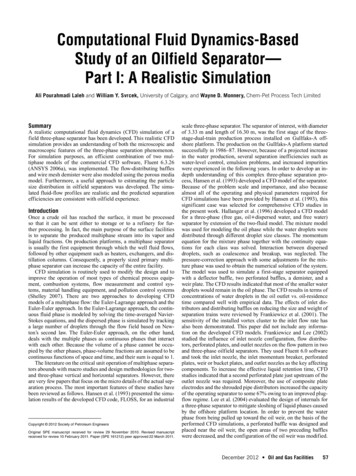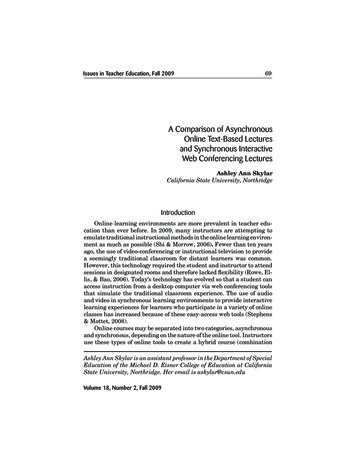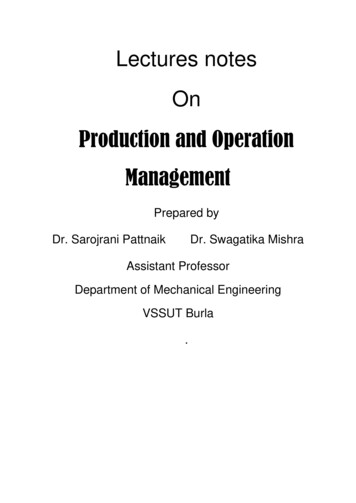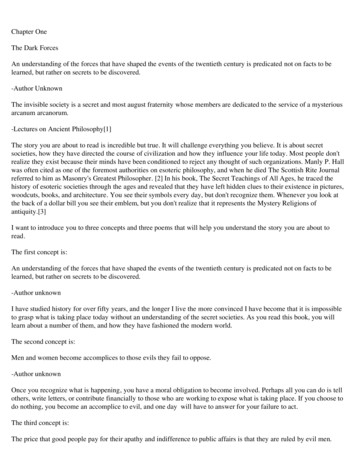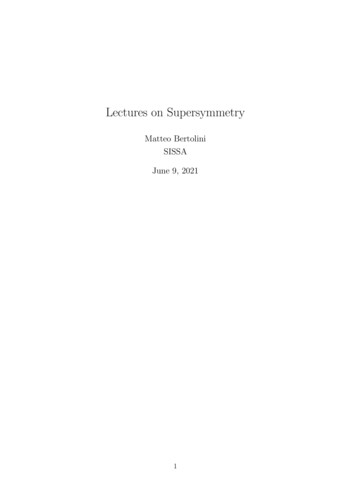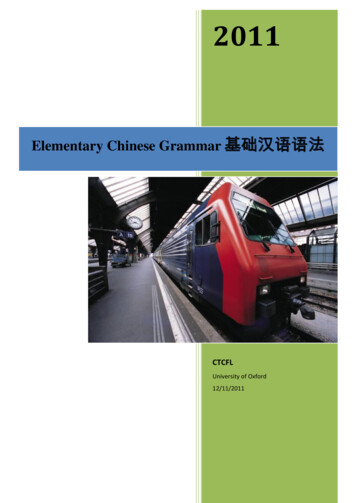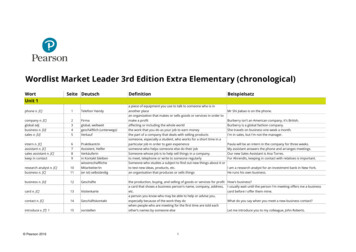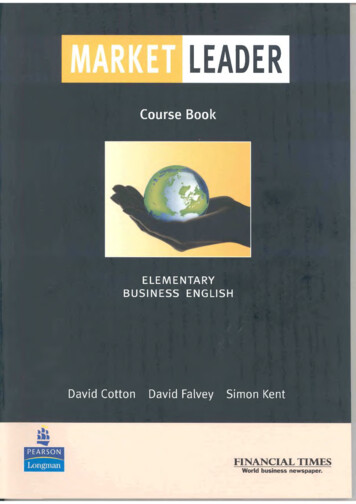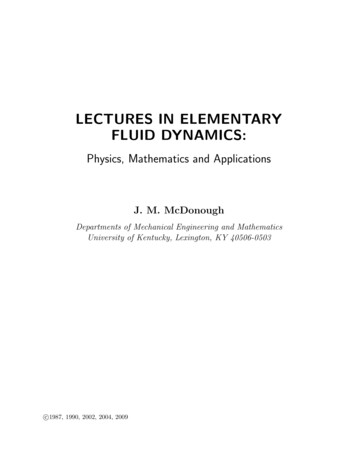
Transcription
LECTURES IN ELEMENTARYFLUID DYNAMICS:Physics, Mathematics and ApplicationsJ. M. McDonoughDepartments of Mechanical Engineering and MathematicsUniversity of Kentucky, Lexington, KY 40506-0503c 1987, 1990, 2002, 2004, 2009
Contents1 Introduction1.1 Importance of Fluids . . . . . . . . . .1.1.1 Fluids in the pure sciences . . .1.1.2 Fluids in technology . . . . . .1.2 The Study of Fluids . . . . . . . . . .1.2.1 The theoretical approach . . .1.2.2 Experimental fluid dynamics .1.2.3 Computational fluid dynamics1.3 Overview of Course . . . . . . . . . . .2 Some Background: Basic Physics of Fluids2.1 The Continuum Hypothesis . . . . . . . . . .2.2 Definition of a Fluid . . . . . . . . . . . . . .2.2.1 Shear stress induced deformations . .2.2.2 More on shear stress . . . . . . . . . .2.3 Fluid Properties . . . . . . . . . . . . . . . .2.3.1 Viscosity . . . . . . . . . . . . . . . .2.3.2 Thermal conductivity . . . . . . . . .2.3.3 Mass diffusivity . . . . . . . . . . . . .2.3.4 Other fluid properties . . . . . . . . .2.4 Classification of Flow Phenomena . . . . . . .2.4.1 Steady and unsteady flows . . . . . . .2.4.2 Flow dimensionality . . . . . . . . . .2.4.3 Uniform and non-uniform flows . . . .2.4.4 Rotational and irrotational flows . . .2.4.5 Viscous and inviscid flows . . . . . . .2.4.6 Incompressible and compressible flows2.4.7 Laminar and turbulent flows . . . . .2.4.8 Separated and unseparated flows . . .2.5 Flow Visualization . . . . . . . . . . . . . . .2.5.1 Streamlines . . . . . . . . . . . . . . .2.5.2 Pathlines . . . . . . . . . . . . . . . .2.5.3 Streaklines . . . . . . . . . . . . . . .2.6 Summary . . . . . . . . . . . . . . . . . . . 04141434445
iiCONTENTS3 The Equations of Fluid Motion3.1 Lagrangian & Eulerian Systems; the Substantial Derivative . . . . .3.1.1 The Lagrangian viewpoint . . . . . . . . . . . . . . . . . . . .3.1.2 The Eulerian viewpoint . . . . . . . . . . . . . . . . . . . . .3.1.3 The substantial derivative . . . . . . . . . . . . . . . . . . . .3.2 Review of Pertinent Vector Calculus . . . . . . . . . . . . . . . . . .3.2.1 Gauss’s theorem . . . . . . . . . . . . . . . . . . . . . . . . .3.2.2 Transport theorems . . . . . . . . . . . . . . . . . . . . . . .3.3 Conservation of Mass—the continuity equation . . . . . . . . . . . .3.3.1 Derivation of the continuity equation . . . . . . . . . . . . . .3.3.2 Other forms of the differential continuity equation . . . . . .3.3.3 Simple application of the continuity equation . . . . . . . . .3.3.4 Control volume (integral) analysis of the continuity equation3.4 Momentum Balance—the Navier–Stokes Equations . . . . . . . . . .3.4.1 A basic force balance; Newton’s second law of motion . . . .3.4.2 Treatment of surface forces . . . . . . . . . . . . . . . . . . .3.4.3 The Navier–Stokes equations . . . . . . . . . . . . . . . . . .3.5 Analysis of the Navier–Stokes Equations . . . . . . . . . . . . . . . .3.5.1 Mathematical structure . . . . . . . . . . . . . . . . . . . . .3.5.2 Physical interpretation . . . . . . . . . . . . . . . . . . . . . .3.6 Scaling and Dimensional Analysis . . . . . . . . . . . . . . . . . . . .3.6.1 Geometric and dynamic similarity . . . . . . . . . . . . . . .3.6.2 Scaling the governing equations . . . . . . . . . . . . . . . . .3.6.3 Dimensional analysis via the Buckingham Π theorem . . . .3.6.4 Physical description of important dimensionless parameters .3.7 Summary . . . . . . . . . . . . . . . . . . . . . . . . . . . . . . . . .4 Applications of the Navier–Stokes Equations4.1 Fluid Statics . . . . . . . . . . . . . . . . . . . . . . . . . . .4.1.1 Equations of fluid statics . . . . . . . . . . . . . . . .4.1.2 Buoyancy in static fluids . . . . . . . . . . . . . . . . .4.2 Bernoulli’s Equation . . . . . . . . . . . . . . . . . . . . . . .4.2.1 Derivation of Bernoulli’s equation . . . . . . . . . . .4.2.2 Example applications of Bernoulli’s equation . . . . .4.3 Control-Volume Momentum Equation . . . . . . . . . . . . .4.3.1 Derivation of the control-volume momentum equation4.3.2 Application of control-volume momentum equation . .4.4 Classical Exact Solutions to N.–S. Equations . . . . . . . . .4.4.1 Couette flow . . . . . . . . . . . . . . . . . . . . . . .4.4.2 Plane Poiseuille flow . . . . . . . . . . . . . . . . . . .4.5 Pipe Flow . . . . . . . . . . . . . . . . . . . . . . . . . . . . .4.5.1 Some terminology and basic physics of pipe flow . . .4.5.2 The Hagen–Poiseuille solution . . . . . . . . . . . . . .4.5.3 Practical Pipe Flow Analysis . . . . . . . . . . . . . .4.6 Summary . . . . . . . . . . . . . . . . . . . . . . . . . . . . 899.101. 101. 102. 108. 109. 110. 113. 116. 116. 118. 122. 122. 124. 126. 126. 129. 133. 158
List of an Free Path and Requirements for Satisfaction of Continuum Hypothesis; (a)mean free path determined as average of distances between collisions; (b) a volumetoo small to permit averaging required for satisfaction of continuum hypothesis. . .Comparison of deformation of solids and liquids under application of a shear stress;(a) solid, and (b) liquid. . . . . . . . . . . . . . . . . . . . . . . . . . . . . . . . . .Behavior of things that “flow”; (a) granular sugar, and (b) coffee. . . . . . . . . . .Flow between two horizontal, parallel plates with upper one moving at velocity U .Physical situation giving rise to the no-slip condition. . . . . . . . . . . . . . . . .Structure of water molecule and effect of heating on short-range order in liquids; (a)low temperature, (b) higher temperature. . . . . . . . . . . . . . . . . . . . . . . .Effects of temperature on molecular motion of gases; (a) low temperature, (b) highertemperature. . . . . . . . . . . . . . . . . . . . . . . . . . . . . . . . . . . . . . . .Diffusion of momentum—initial transient of flow between parallel plates; (a) veryearly transient, (b) intermediate time showing significant diffusion, (c) nearly steadystate profile. . . . . . . . . . . . . . . . . . . . . . . . . . . . . . . . . . . . . . . . .Interaction of high-speed and low-speed fluid parcels. . . . . . . . . . . . . . . . . .Pressure and shear stress. . . . . . . . . . . . . . . . . . . . . . . . . . . . . . . . .Surface tension in spherical water droplet. . . . . . . . . . . . . . . . . . . . . . . .Capillarity for two different liquids. . . . . . . . . . . . . . . . . . . . . . . . . . . .Different types of time-dependent flows; (a) transient followed by steady state, (b)unsteady, but stationary, (c) unsteady. . . . . . . . . . . . . . . . . . . . . . . . . .Flow dimensionality; (a) 1-D flow between horizontal plates, (b) 2-D flow in a 3-Dbox, (c) 3-D flow in a 3-D box. . . . . . . . . . . . . . . . . . . . . . . . . . . . . .Uniform and non-uniform flows; (a) uniform flow, (b) non-uniform, but “locallyuniform” flow, (c) non-uniform flow. . . . . . . . . . . . . . . . . . . . . . . . . . .2-D vortex from flow over a step. . . . . . . . . . . . . . . . . . . . . . . . . . . . .3-D vortical flow of fluid in a box. . . . . . . . . . . . . . . . . . . . . . . . . . . .Potential Vortex. . . . . . . . . . . . . . . . . . . . . . . . . . . . . . . . . . . . . .Laminar and turbulent flow of water from a faucet; (a) steady laminar, (b) periodic,wavy laminar, (c) turbulent. . . . . . . . . . . . . . . . . . . . . . . . . . . . . . . .da Vinci sketch depicting turbulent flow. . . . . . . . . . . . . . . . . . . . . . . . .Reynolds’ experiment using water in a pipe to study transition to turbulence; (a)low-speed flow, (b) higher-speed flow. . . . . . . . . . . . . . . . . . . . . . . . . .Transition to turbulence in spatially-evolving flow. . . . . . . . . . . . . . . . . . .(a) unseparated flow, (b) separated flow. . . . . . . . . . . . . . . . . . . . . . . . .Geometry of streamlines. . . . . . . . . . . . . . . . . . . . . . . . . . . . . . . . . .Temporal development of a pathline. . . . . . . . . . . . . . . . . . . . . . . . . . .iii. 12.14141617. 20. 21.2122262728. 30. 30.32343536. 38. 38.3939404244
ivLIST OF .25Fluid particles and trajectories in Lagrangian view of fluid motion. . . . . . . . . .Eulerian view of fluid motion. . . . . . . . . . . . . . . . . . . . . . . . . . . . . . .Steady accelerating flow in a nozzle. . . . . . . . . . . . . . . . . . . . . . . . . . .Integration of a vector field over a surface. . . . . . . . . . . . . . . . . . . . . . . .Contributions to a control surface: piston, cylinder and valves of internal combustionengine. . . . . . . . . . . . . . . . . . . . . . . . . . . . . . . . . . . . . . . . . . . .Simple control volume corresponding to flow through an expanding pipe. . . . . . .Time-dependent control volume for simultaneously filling and draining a tank. . .Calculation of fuel flow rate for jet aircraft engine. . . . . . . . . . . . . . . . . . .Schematic of pressure and viscous stresses acting on a fluid element. . . . . . . . .Sources of angular deformation of face of fluid element. . . . . . . . . . . . . . . . .Comparison of velocity profiles in duct flow for cases of (a) high viscosity, and (b)low viscosity. . . . . . . . . . . . . . . . . . . . . . . . . . . . . . . . . . . . . . . .Missile nose cone ogive (a) physical 3-D figure, and (b) cross section indicating linearlengths. . . . . . . . . . . . . . . . . . . . . . . . . . . . . . . . . . . . . . . . . . .2-D flow in a duct. . . . . . . . . . . . . . . . . . . . . . . . . . . . . . . . . . . . .Prototype and model airfoils demonstrating dynamic similarity requirements. . . .Wind tunnel measurement of forces on sphere. . . . . . . . . . . . . . . . . . . . .Dimensionless force on a sphere as function of Re; plotted points are experimentaldata, lines are theory (laminar) and curve fit (turbulent). . . . . . . . . . . . . . .Hydraulic jack used to lift automobile. . . . . . . . . . . . . . . . . . . . . . . . . .Schematic of a simple barometer. . . . . . . . . . . . . . . . . . . . . . . . . . . . .Schematic of pressure measurement using a manometer. . . . . . . . . . . . . . . .Application of Archimedes’ principle to the case of a floating object. . . . . . . . .Stagnation point and stagnation streamline. . . . . . . . . . . . . . . . . . . . . . .Sketch of pitot tube. . . . . . . . . . . . . . . . . . . . . . . . . . . . . . . . . . . .Schematic of flow in a syphon. . . . . . . . . . . . . . . . . . . . . . . . . . . . . .Flow through a rapidly-expanding pipe. . . . . . . . . . . . . . . . . . . . . . . . .Couette flow velocity profile. . . . . . . . . . . . . . . . . . . . . . . . . . . . . . .Plane Poiseuille flow velocity profile. . . . . . . . . . . . . . . . . . . . . . . . . . .Steady, fully-developed flow in a pipe of circular cross section. . . . . . . . . . . . .Steady, 2-D boundary-layer flow over a flat plate. . . . . . . . . . . . . . . . . . . .Steady, fully-developed pipe flow. . . . . . . . . . . . . . . . . . . . . . . . . . . . .Turbulent flow near a solid boundary. . . . . . . . . . . . . . . . . . . . . . . . . .Graphical depiction of components of Reynolds decomposition. . . . . . . . . . . .Empirical turbulent pipe flow velocity profiles for different exponents in Eq. (4.53).Comparison of surface roughness height with viscous sublayer thickness for (a) lowRe, and (b) high Re. . . . . . . . . . . . . . . . . . . . . . . . . . . . . . . . . . . .Moody diagram: friction factor vs. Reynolds number for various dimensionless surface roughnesses. . . . . . . . . . . . . . . . . . . . . . . . . . . . . . . . . . . . . .Time series of velocity component undergoing transitional flow behavior. . . . . . .Simple piping system containing a pump. . . . . . . . . . . . . . . . . . . . . . . .Flow through sharp-edged inlet. . . . . . . . . . . . . . . . . . . . . . . . . . . . . .Flow in contracting pipe. . . . . . . . . . . . . . . . . . . . . . . . . . . . . . . . .Flow in expanding pipe. . . . . . . . . . . . . . . . . . . . . . . . . . . . . . . . . .Flow in pipe with 90 bend. . . . . . . . . . . . . . . . . . . . . . . . . . . . . . . .Liquid propellant rocket engine piping system. . . . . . . . . . . . . . . . . . . . .48495154.636466677476. 82.84868993. 7. 138.139140145149150151152153
Chapter 1IntroductionIt takes little more than a brief look around for us to recognize that fluid dynamics is one of themost important of all areas of physics—life as we know it would not exist without fluids, andwi
LECTURES IN ELEMENTARY FLUID DYNAMICS: Physics, Mathematics and Applications J. M. McDonough Departments of Mechanical Engineering and Mathematics
